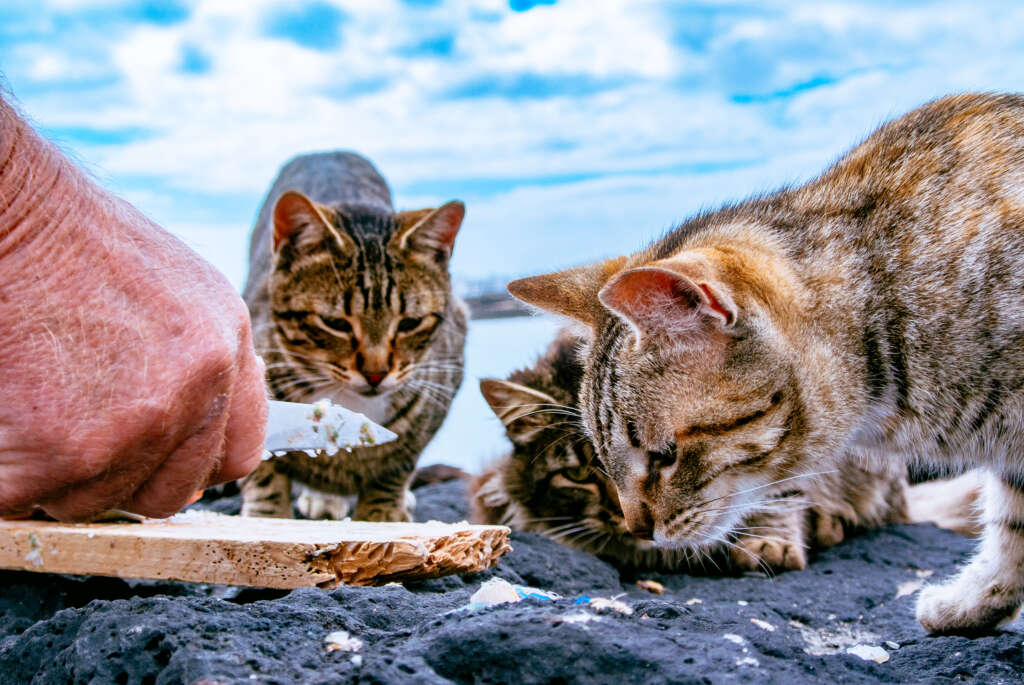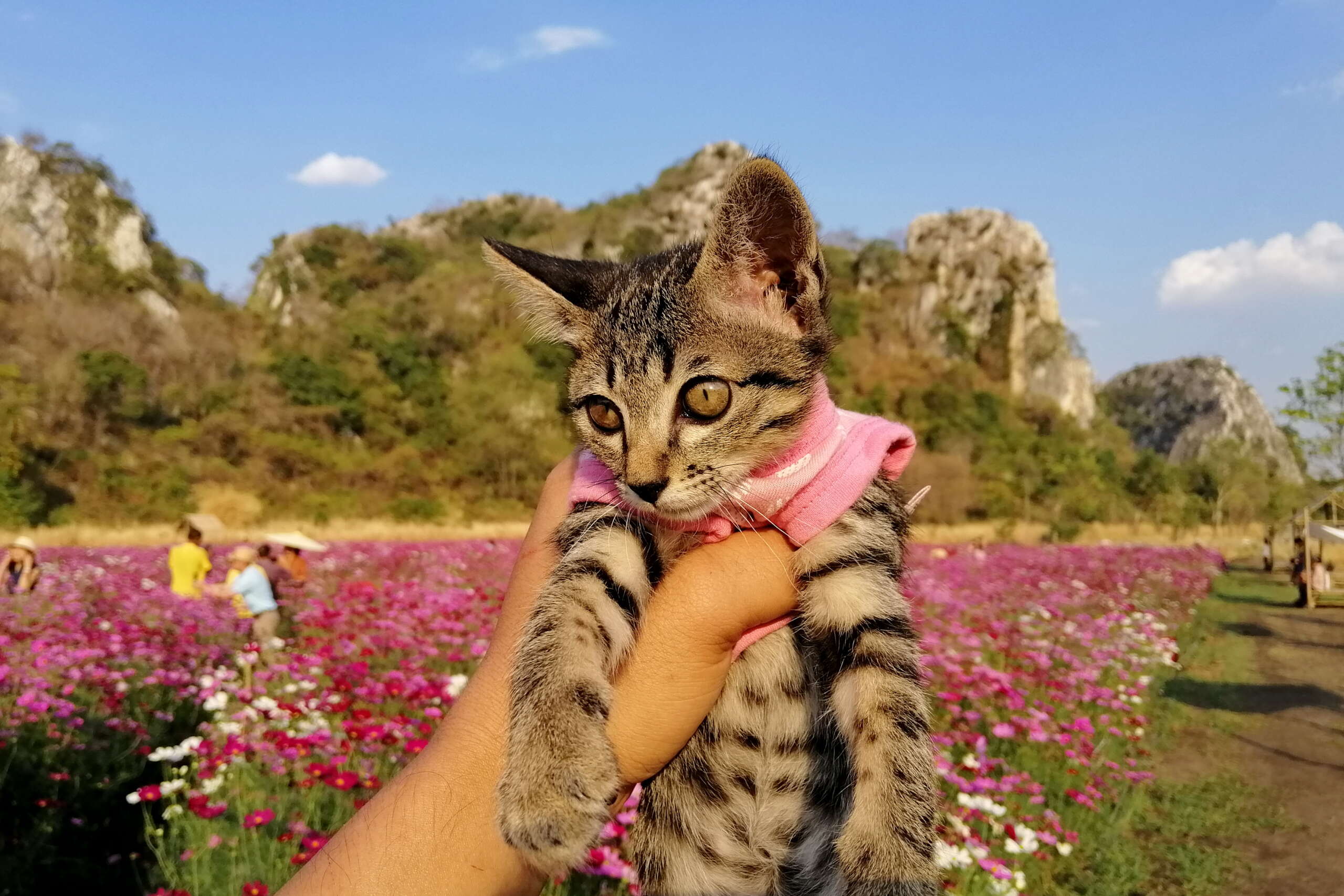Share This Article
Our cats might dream of the great outdoors, but is it safe for them? An outdoor cat safety plan is not just a good idea; it’s essential. While letting them explore can make their lives better, it also comes with dangers like car accidents and wild animals.
With outdoor cat safety tips, we can find a balance between fun and safety. This balance is key to keeping our cats happy and healthy.
Outdoor cats live only 2-5 years, while indoor cats can live up to 15-17 years. This shows how risky the outdoors can be. Protecting your cat on outdoor trips means more than just keeping them safe. It’s about giving them a long, happy life.
Leash training, cat enclosures, and vaccinations are important. They help our cats stay safe in the wild. But how do we make sure they can explore safely and come back home?
We need to use tools like GPS trackers and microchips. They help us keep track of our cats and ensure a quick reunion if they get lost. Flea and tick prevention is also crucial. This is where AKC Pet Insurance comes in, offering protection against unexpected medical needs.
Let’s dive into outdoor cat safety measures. We’ll look at creating a safe outdoor space, the importance of identification, and vaccinations and parasite control. This guide will show you how to keep your cat’s outdoor adventures safe and fun.
Understanding the Risks: Why Outdoor Freedom Needs Safeguards
The great outdoors is a tempting place for many cats. It’s full of excitement and danger. With 100 million free-roaming cats in America, keeping them safe is crucial. They face many threats, like road accidents and poisoning, and dangers from other wildlife.

Male cats tend to explore more than females. This makes them more likely to get into trouble. Ornithologist Peter Marra found that outdoor cats kill 1.3 billion birds and 6.3 billion mammals each year. This shows how they affect local wildlife.
Despite the dangers, outdoor life is good for cats. It lets them hunt and explore. So, finding a safe way for them to enjoy the outdoors is key. Secure outdoor enclosures are a good option.
Keeping cats safe isn’t just about avoiding accidents. It’s also about their happiness and health. Outdoor cats usually live shorter lives than indoor ones. Vaccinations, ID, and safety measures like microchipping can help. They ensure cats live longer, healthier lives outdoors.
In summary, while cats love the outdoors, we must protect them. Understanding the risks and taking steps to keep them safe is vital. This balance keeps them healthy, satisfies their instincts, and protects wildlife. It’s a must for every cat owner.
Cat Safety Outdoors: Ensuring Safe External Environments
Exploring the outdoors with cats requires careful planning. Outdoor cats face dangers like car accidents and fights with other animals. This shows how important it is to keep them safe.
Teaching cats to walk on a leash is key. It lets them enjoy the outdoors while avoiding dangers. Creating a safe outdoor space, like a catio, also helps. It lets them experience nature without risks.

Having a safe place for cats to go in emergencies is crucial. This could be a catio or a secure room. Regular vet visits and vaccinations also protect them from diseases.
It’s also important to check your garden for dangers. Look out for toxic plants and unguarded water. This makes your garden safer for your cat.
Following these safety tips can greatly improve your cat’s outdoor life. Each step you take helps keep them safe while still letting them explore. It’s all about finding a balance between safety and freedom.
The Importance of Identification in Outdoor Cat Safety
It’s vital to make sure your cat can be easily found if they go missing. A collar with an ID tag is key for cat safety gear for outdoor adventures. It gives immediate contact info if your cat strays too far. Groups like International Cat Care and American Humane stress how important ID tags are for your cat’s safety and return.
Using ID tags and training your cat to wear a collar can lower risks when they go outside. Collars with safety release clasps prevent choking, and reflective parts make them more visible at night. Experts say to start training your cat to wear a collar early, so it becomes a normal part of their life.
Microchips also help in identifying your cat, even if they can’t track them in real time. They’re great for getting a lost cat back home, especially if it ends up in a shelter. For constant tracking, a GPS tracker is a good addition to your cat’s safety gear for outdoor adventures. It lets you keep an eye on your cat’s location.
It’s also important to keep your cat’s ID up to date. Many lost cats are found quickly because of their ID tags. Make sure the ID tag has all the important info, like your contact numbers and any health details. Update it if anything changes.
Tips for outdoor cat safety include making your cat visible and identifiable. It’s also good to join community efforts like TNR programs. These programs help manage feral cat populations, improving the lives of both domestic and community cats.
Protective Measures: Vaccinations and Parasite Control
Keeping your cat safe on outdoor trips is crucial. Vaccinations are key to protecting them from dangers like rabies and cat flu. These shots are especially important for cats going on outdoor adventures, where they meet other animals and viruses.
Effective parasite control is also vital for outdoor cats. Fleas, ticks, and mosquitoes can harm them. Using monthly preventatives can lower these risks. Deworming should be done regularly, every three to six months, based on your cat’s outdoor time.
Long-term health is also important. Spaying or neutering your cat can prevent overpopulation and reduce roaming. A customized vaccination and parasite prevention plan is essential for your cat’s health.
Regular vet visits are crucial. A vet can give advice based on your cat’s health and outdoor activities, helping in protecting your cat on outdoor trips.
By taking these steps, you make your pet’s outdoor adventures safer and more enjoyable. These actions strengthen your bond with your cat, making every journey memorable and safe.
Training and Supervision: Nurturing a Safe Exploration Routine
In the world of cat care, keeping cats safe outdoors means more than just a shelter. It’s about training and watching them closely. Teaching cats to walk on a leash is a key part of this. It lets them explore safely and helps manage risks.
Watching them when they go outside is crucial. It lets them see the world while staying safe. This is especially important at dawn and dusk when dangers are higher. Using GPS trackers can help keep them safe when you can’t watch them.
Also, having a regular routine helps cats stay close to home. Creating a safe area for them to play outside is good too. About 58% of cat owners do this to keep their pets safe and happy.
The main aim is to let cats explore while keeping them safe. With the right steps, our pets can enjoy the outdoors without risk.
Comfort and Care: Providing Shelter and Sustenance for Your Adventure Cat
Keeping your adventure cat comfortable and safe is key, especially when they go outside. As it gets colder, especially below 45°F, they need places to hide from the cold. This is especially true for kittens, older, or sick cats.
Warm shelters or heated spots are a must to keep them safe. This helps a lot with outdoor cat safety tips.
Adventure cats need more food to keep up their energy. Make sure they always have fresh food and water. This helps keep them healthy and full of energy. By doing this, you avoid dehydration and malnutrition, big dangers for active cats.
To make your outdoor area safer, think about a ‘catio’—a safe patio for cats. Use mesh that cats can’t scratch and fun, safe spots for them to play. Add comfy places for them to rest. All these steps are important for adventure cat safety. They let your cat enjoy the outdoors safely.
Contingency Planning: GPS Trackers and Microchips for Cat Security
Pet security is a top priority for many owners. Microchips are key, with 50% of colony cats being chipped. This greatly increases their chances of being found if lost. After natural disasters, 65% of lost cats are found thanks to detailed records and photos.
GPS tracking collars are a game-changer for keeping tabs on your cat. They use light sensors for motion detection, balancing power and cost. Microchips are a backup when collars are lost, linking your cat to you with just a scan.
Local studies show that 80% of shelters are ready for high winds. This shows that cat safety goes beyond just individual efforts. Preparing for emergencies helps, with 75% of cats benefiting from extra food and care. Knowing the ratio of friendly to feral cats is also crucial, especially before storms.
Using GPS and microchips together creates a strong safety net for outdoor cats. It ensures they can explore safely while being protected.


